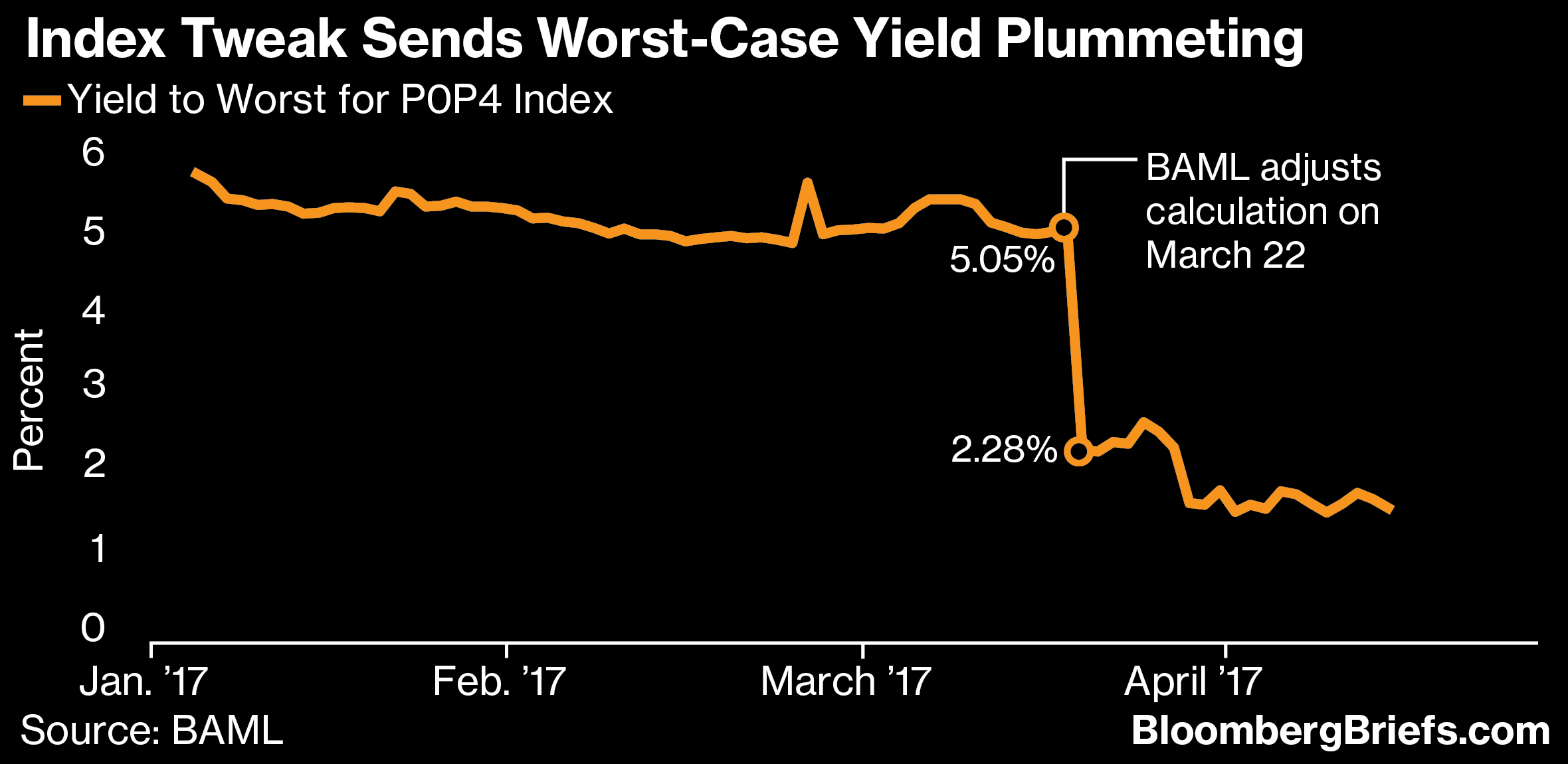By Carolina Wilson
(Bloomberg) --Investors in the $4.9 billion PowerShares Preferred Portfolio, one of the biggest funds focusing on preferred shares, last month found that a huge chunk of their potential returns had vanished in short order.
A key measure of the yield for the exchange-traded fund’s underlying index plunged by nearly 3 percentage points on March 22. The change came because the index switched the way it calculates the metric known as yield to worst, which indicates the investor’s income from the fund in a worst-case-scenario.
The dropping yield underscores how investors in ETFs and other passive instruments, who are often looking to reduce the risk of high fees and bad stock or bond picks cutting into returns, can still be hurt by changes to their indexes. The PowerShares fund tracks an index of preferred shares that is managed by Bank of America Corp.
“The old way of calculating the yield to worst was flawed,” said Phil Jacoby, chief investment officer of Spectrum Asset Management, which has more than $21 billion of preferred shares under management. “Now you can take a look at what these ETFs could potentially be yielding, and it’s not much.”
A spokeswoman for Bank of America declined to comment beyond a note it sent to clients including Invesco Ltd.’s PowerShares last month, describing the change to its calculation methods. Bloomberg parent company Bloomberg LP runs indexes of its own.

The big decline in potential returns in Bank of America’s index stemmed from the yield-to-worst measure, which represents the yield investors would receive if issuers bought back their securities at face value en masse as soon as they were eligible to, instead of continuing to pay dividends at their current levels. That measure dropped to 2.28 percent on March 22 from 5.05 percent the day before. The current level for the index the ETF tracks, namely the Bank of America Merrill Lynch Core Plus Fixed Rate Preferred Securities Index, is around 1.52 percent.
Individual investors in the funds usually pay more attention to a different measure of yield, known as the distribution yield, which for the PowerShares Preferred Portfolio is now around 5.6 percent. That represents the portfolio’s payouts if dividends continue at their current levels.
An investor’s actual income from a fund over time will typically be somewhere between these two measures -- given current assets, the yield to worst is the lowest possible income, and the distribution yield is a sort of ceiling. The more preferred shares in the fund that get called, the closer the investor’s income will be to the yield-to-worst measure, as companies buy back higher-yielding preferred shares and the fund’s potential income declines.
Call Risk
Investors ignore the yield to worst at their peril, said Andrei Costas, a senior investment analyst at STA Wealth Management LLC, which sold its holdings in the ETF in February.
“Changing the yield to worst can change the return profile. It factors into an investor’s decision whether to buy or sell a fund,” Costas said. For the PowerShares Preferred Portfolio, the yield to worst is less than a third of the distribution yield.
James Meyers, director of fixed income at PowerShares, said in an interview by telephone, “We think some other yield calculations are more important,” including yield to maturity and distribution yield.
Bank of America’s changing methodology reflects the fact that many of the securities in the index could have negative yields if companies call them. After interest rates fell post crisis, the value of many preferred shares jumped above face value and may still remain there -- the securities in the index trade on average at around 105 cents on the dollar, according to Bank of America Merrill Lynch index data. If the securities were now bought back for 100 cents on the dollar, investors could suffer losses that make the yields to worst negative.
Last month, Bank of America Merrill Lynch started accounting for the fact that some preferred shares had negative yields to worst. Before, the bank ignored any such measures that were negative for individual securities, and used a different yield measure for those securities instead when determining the index’s overall yield to worst.
The PowerShares Preferred Portfolio is the second-biggest ETF focusing on preferreds, behind the iShares U.S. Preferred Stock ETF, which has around $17.5 billion of assets.
To contact the reporter on this story: Carolina Wilson in New York City at [email protected] To contact the editors responsible for this story: Yakob Peterseil at [email protected] Dan Wilchins, Eric J. Weiner





